Foods Turning 100 In 2024
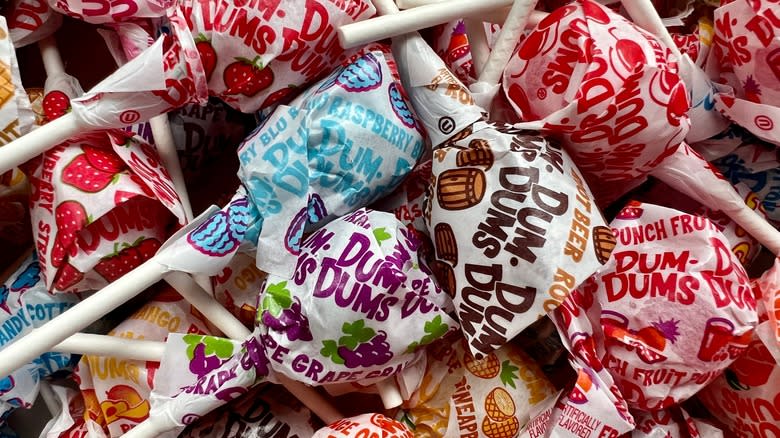
1924 was quite a year for hellos, goodbyes, introductions, and mergers for many names still familiar a century on. The world became a more entertaining place when the likes of Marlon Brando, Truman Capote, Lee Marvin, James Baldwin, and Lauren Bacall entered it. We said goodbye to Vladimir Lenin, Woodrow Wilson, Franz Kafka, and Giacomo Puccini, and it was the last time a California grizzly bear was ever sighted. C-T-R became IBM, three movie studios merged to become Metro-Goldwyn-Mayer, and the very first Winter Olympic Games were held in Chamonix, France. The song "It Had To Be You" warmed ears and hearts, and in the eating department, fourteen foods were first created that are still warming bellies and souls to this day.
In 1924, the hamburger finally got the topping it always needed, a tangy Roman-sounding salad was whipped up in Tijuana, and a famous pasta dish got rolling in Italy. For those with a sweet tooth in Australia, Canada, Denmark, and the United States, things got even sweeter with priceless penny candies that still make eaters feel nostalgic now, a century later. Let's take a look back at these 14 iconic foods, how they came to be, and celebrate that they're still with us. Happy 100 birthday to you all. May you last 1,000 years!
Read more: 11 Discontinued Chocolates We Miss The Most
B-B-Bats And Kits Taffy
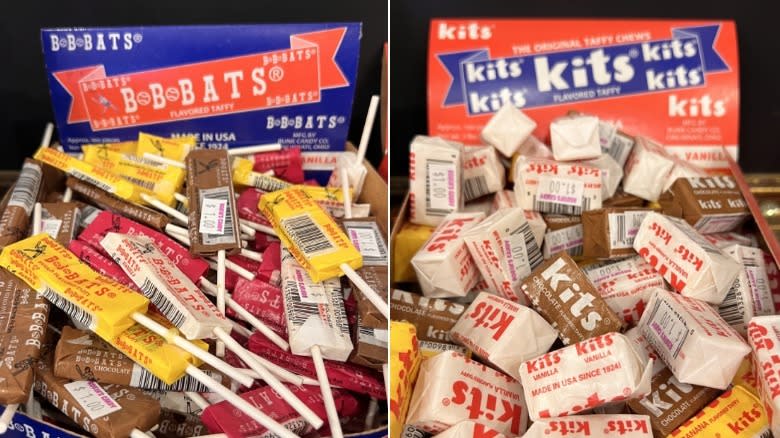
In 1924, Fair Play Caramels of Johnson City, New York doubled up candy fans' pleasure when it introduced taffy in two forms — on a stick with B-B-Bats, and in square, bite-sized pieces with Kits. The two Bs stand for "Bigger and Better," and the wrapper played up its baseball theme with two balls between the Bs, and a batter ready to take a swing. Former Fair Play Caramels co-owner, Olin B. Fellows III told the Press and Sun-Bulletin, "With the B-B-Bat, it's a piece of candy that lasts awhile. You get your money's worth."
At one point, B-B-Bat sold for a penny, and you could get four Kits for the same low price. The company produced 7 million of them a day, in banana, chocolate, peanut butter molasses, strawberry, and vanilla flavors. Kits was such a popular brand that the chocolate flavor of the taffy was even included in C Ration kits distributed to U.S. soldiers during World War II.
After Fair Play was acquired by Gilliam Candy Co. in 1990, B-B-Bats and Kits became harder to find in stores. The two taffy brands would constantly be on the move thereafter, going from one candy company to another. Today they're made in Reading, Pennsylvania by Mega Candy Company, a division of Stichler Products Inc.
Bit-O-Honey
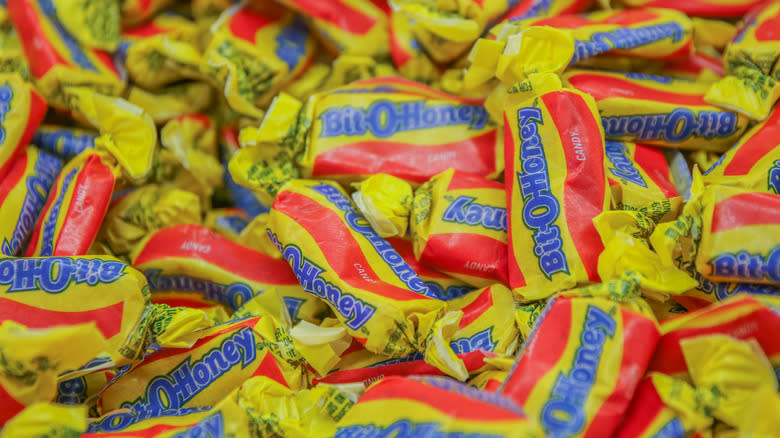
There was a song from 1917 called "A Little Bit o' Honey," and seven years later those last three words were turned into a candy bar by the Schutter-Johnson Company of Chicago. A Bit-O-Honey is where honey, butter, and toasted almonds come together in a toffee-like candy. Alongside long-forgotten brethren bars like "Old Nick" and "Orange Grove," it was advertised as "The five cent candy with the ten cent taste" (via The Detroit Free Press). Bit-O-Honey was eventually also offered in a bite-sized piece and, with similar packaging, has been often confused with the candy Mary Jane, which was introduced in 1914.
Bit-O-Honey's catchy name was used to expand the brand with short-lived bars such as Bit-O-Coconut, Bit-O-Chocolate, Bit-O-Licorice, and Bit-O-Peanut Butter. The candy bounced around various owners from the Ward Candy Company to Nestle to Pearson's Candy Company. In 2020, the Spangler Candy Company acquired Bit-O-Honey, adding it to a roster that also includes another iconic candy that's turning 100 in 2024 — Dum-Dums.
In May 2023, the Spangler Candy Company gave the brand a fresh new look and enhanced taste. In a press release about the Bit-O-Honey rebrand, CEO Kirk Vashaw said, "We've always loved the brand's unique flavor profile, and now we've improved the consistency of the candy's smooth texture to help bring out those honey and almond flavors. We're excited to introduce a whole new audience to Bit-O-Honey."
Caesar Salad

The long hailed Caesar Salad did got its start not in Rome, but in Tijuana, Mexico. That is where Italian chef Caesar Cardini had a restaurant, and over the July 4th weekend of 1924, he whipped up something quite special there. Cardini recalled the story in 1956, saying, "I rubbed a bowl with garlic, broke up the romaine and coddled the eggs. I had my cooks cut up the stale bread and soak it in olive oil, then put it in the oven to toast, mixed the eggs and lettuce with pear vinegar and green olive oil, added the grated cheese and toasted croutons. That was it." (via The Idaho Statesman)
Caesar's salad started to gain a following during the prohibition era when Hollywood types like Carole Lombard, Clark Gable, and Jean Harlow came south of the border to gobble it up. Soon, the recipe made its way northward, and every Los Angeles restaurant tried to make Caesar's salad their own. Cardini eventually moved there himself, running a grocery store and selling his dressing. While he was not a fan of those who deviated from this original recipe, including adding anchovies, he told the United Press, "I am proud that this is my creation."
His creation is still being made tableside at Caesar's Place in Tijuana, which has been at its present location since 1927. Hopefully, he wouldn't be too offended that today, anchovies are a main ingredient, together with Worcestershire sauce and Dijon mustard.
Cannelloni

Before cannelloni went by that name, the fabulously filling tubular pasta dish was first known as strascinati. That dish's origin has been tied to Antonino Ercolano's Ristorante 'o Parrucchiano la Favorita in Sorrento, Italy, where it was first served sometime in the 19th century.
In the Amalfi coast area, two former 13th-century monasteries were turned into modern, picturesque hotels in the late 19th century — Hotel Luna and Hotel Cappuccini. The hotels had kitchens with friendly rivalries that tried to outdo the other with innovative dishes. When one made a worthy dish, the proprietor of the other hotel would pass judgment by taste-testing it. The Cappuccini's chef was Salvatore Coletta, who had encountered strascinati at Ristorante 'o Parrucchiano la Favorita, and the story goes that in August of 1924, he put his own spin on it. The resulting dish was cannelloni, and the Luna Hotel's owner was so taken with it that he demanded that the monastery's bells ring out in its honor.
The Cappuccini Hotel is now known as the Anantara Convento di Amalfi Grand Hotel, but cannelloni is still honored there to this day. One can find it on the menu, where it's currently filled with eggplant Parmesan and basil pearls, or even take a cooking class with Chef Claudio Lanuto, and learn how to make cannelloni right where it all started.
The Cheeseburger
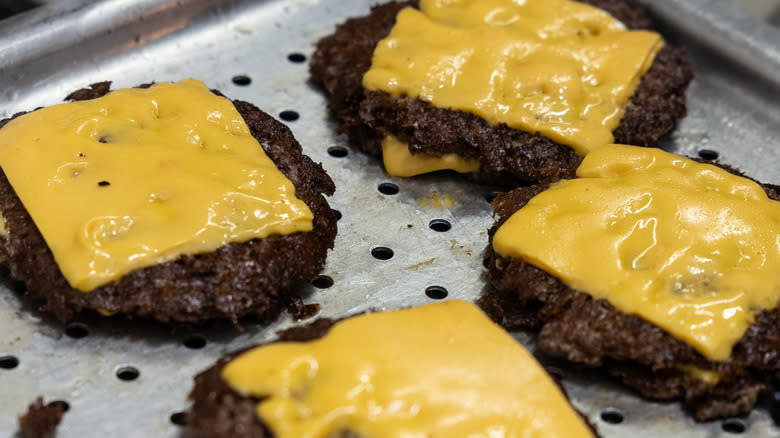
The origin of the hamburger is complicated. The cheeseburger, not so much. Hard to believe it's only been around for 100 years, but 1924 is the accepted year of its origin, thanks to greasy trailblazer Lionel Sternberger.
Sternberger ran a Pasadena soft drink stand in the same very spot where his father's fruit stand once stood. After a stretch of slow business, he and a friend had the bright idea of putting a slice of cheese atop a hamburger. At first, Sternberger was apprehensive to feature a familiar item with a new topping at a higher cost, but eventually gave it a shot. In 1931, The Pasadena Post recalled, "The next day an automobile with six passengers halted at the door. The driver asked: 'Is this where hamburgers with cheese are served?' Sternberger didn't know what to say for a moment. He finally said 'Yes.' The sandwiches went so well the party repeated their order. That started persons to the top of the hill for hamburger sandwiches with cheese."
Sternberger's roadside stand was then a part of Route 66, and was eventually, aptly named The Rite Spot. The burgers sold for 15¢ and were listed on the menu as "Aristocratic Burger: the Original Hamburger with Cheese." By 1932, these tasty morsels were filling bellies across America, now going by a more familiar name — the cheeseburger. Today, a small plaque at 1500 West Colorado Boulevard in Pasadena commentates Sternberger's invention, in the exact Rite Spot where it all began.
Cherry Ripe
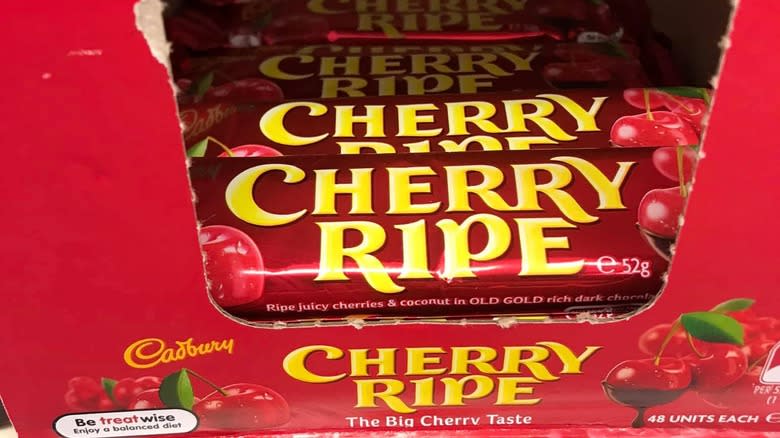
When it comes to candy bars from Down Under, there may perhaps be none that's older or more revered than Cherry Ripe. The bar came to be in 1924 and ads in via The Daily Advertiser described it as being "made from the choicest Australian cherries, blended with coconut and coated with rich 'old gold' chocolate." Cherry Ripe was the brainchild of Leslie Atkinson, who worked for confectioner MacRobertson's of Fitzroy, Victoria. Even though Cadbury acquired the candy maker in 1967, MacRobertson's name still adorned wrappers of Cherry Ripe up until 2002.
The distinct taste of Cherry Ripe has made it ripe for other products, including ice cream, ice cream bars, and in 2023, filling and dipping donuts in collaboration with Krispy Kreme. The candy has a huge admirer in musician Keith Urban. While isolating during the pandemic in Tennessee, he told The Project "We're really anxious to get back [to Australia and] stock back up on these [holds up a Cherry Ripe bar] cause I'm down to the last one, which is tragic." (via Daily Mail). Not sure his wife Nicole Kidman fully agrees, as she mentioned on Friday Night with Jonathan Ross in 2003, "I would go for a Violet Crumble over a Cherry Ripe."
Dum-Dums
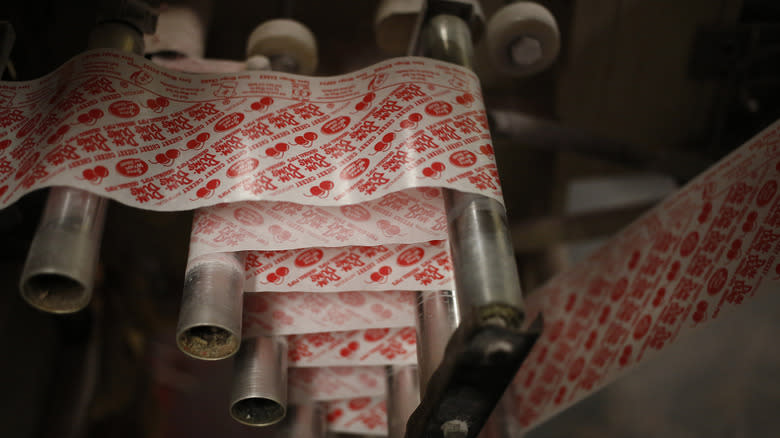
Bullet Pops were once all the rage in the lollipop game, and the Akron Candy Co. from Bellevue, Ohio wanted to find similar success with its own sucker. Co-owner Lloyd D. Bader drummed up a new, rounded lollipop on a paper stick, and the sales manager C. Frederic Bahr came up with its unforgettable name — Dum-Dum. The moniker was derived from a World War I bullet, which in turn borrowed its name from a city in West Bengal, India. As Bahr once said to the Akron Beacon Journal, "Our chief business is naturally with the children, and it is a word a 2-year-old can say."
Dum-Dums were a true penny candy, initially running the full gamut of candy flavors, including anise, butterscotch, cherry, chocolate, grape, lemon, lime, orange, raspberry, and even root beer. In 1953, Spangler Candy bought the Dum-Dum brand from the Akron Candy Co., and within six years was producing 2 million lollipops a day. The colorful wrappers of Dum-Dums have always been eye-catching and, for almost six decades, they could be traded in for toys thanks to the company's "Save Wraps For Stuff" program.
Dum-Dums continue to be produced at Spangler's factory in Bryan, Ohio, which has been affectionately dubbed the Lollipop Capital of the World. Slightly over a decade ago, Company president and CEO Kirk Vashaw told Ohio Magazine, "Yes, we make 10 million Dum Dums a day, but we really make 10 million smiles a day," adding "That's really the business we're in."
Jersey Milk
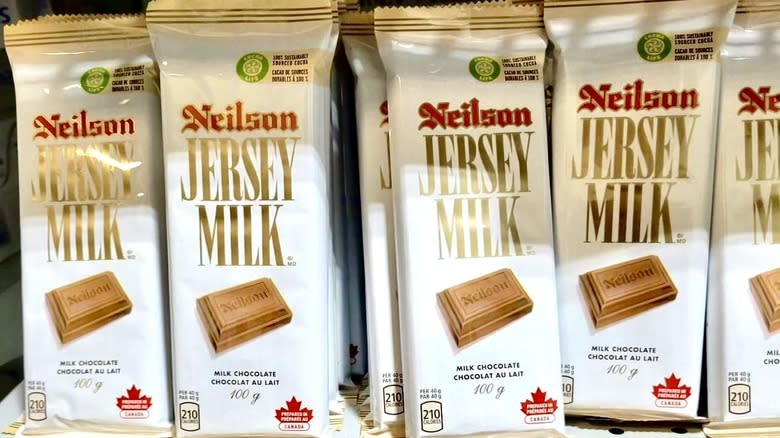
William Neilson made a name for himself and his family with a Toronto dairy that he started in 1893 with only seven cows. Neilson's Dairy signature items were milk and ice cream, but to keep his employees busy during wintertime, chocolate production was added to the portfolio in 1906. Neilson's son Morden succeeded him after his death in 1915, continuing to push the company into sweeter pastures and building it into one of Canada's largest producers of chocolate. In 1924, the chocolate bar Jersey Milk made its debut. It would go on to become one of the company's best sellers. Advertising for the product used to purport that "Experts say the habit of eating a bar of Jersey Milk Chocolate every day is a healthful one to form." (via Vox Lycei).
The company was eventually broken up into pieces, with Neilson's Dairy unit currently owned by Saputo. As for the confections, they landed under the keep of Cadbury Chocolate Canada Inc. which, in turn, is now a part of Mondelez International. The only remaining chocolate item on the roster, sold bearing the good Neilson name, is Jersey Milk.
Lois Dillon, a former vice-president of sales and marketing for Neilson's, summed up the bar's longevity to The Hamilton Spectator, saying "It's a Canadian favorite — everyone has soft nostalgic feelings about Jersey Milk as they grew up." She added, "It's a pure chocolate for a mother to give a child."
Milky Way

Frank C. Mars had been struggling to build a career in making and selling candy since the 1910s, but finally found an out-of-this-world hit thanks to an idea from his estranged son Forrest in 1923. Per the Washington Post, Forrest asked his father a fortuitous question while sipping on malts, "Why don't you put a chocolate-malted drink in a candy bar?" A year later, the Milky Way candy bar, filled with chocolate, caramel, and nougat, started selling for 5¢ and became a big bang all the way to the bank. For the record, the moniker has nothing to do with the galaxy of the same name.
While hits like Snickers and 3 Musketeers followed (claiming to use "one-third of all the malted milk produced in the United States" by 1931), the father-son relationship had a falling out, leaving Forrest with foreign rights to Milky Way. Forrest resurfaced in England where he produced his version of Milky Way, sold then and today as the Mars Bar. To make international chocolate bars even more confusing, in Europe, 3 Musketeers is sold under the name Milky Way.
There have also been variations on the American Milky Way. The company released a vanilla one that became known as Forever Yours, a dark "Midnight" one, and recently Salted Caramel and Cookie Dough versions. The bar inspired the name of Frank Mars' Tennessee farm, was hawked by Buster Keaton on TV, and was even featured in the infamous knife and fork episode of "Seinfeld."
Pork Chop Sandwich
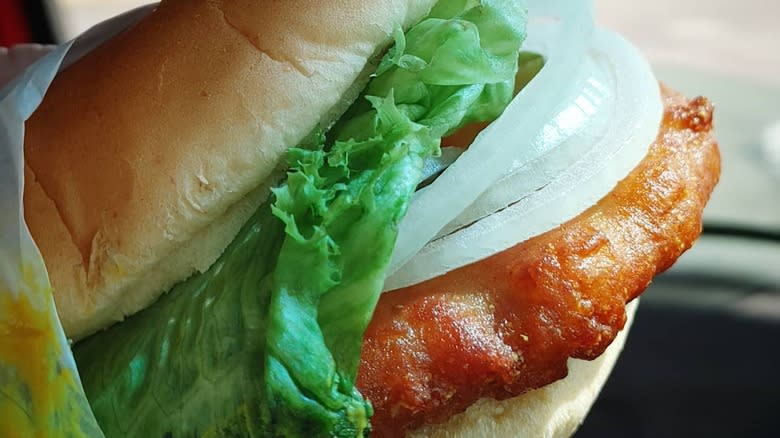
The mining town of Butte, Montana is the birthplace of stuntman Evel Knievel, home to America's longest continuously operating Chinese restaurant, the Pekin Noodle Parlor, and the first place to serve a pork chop sandwich. John Burklund whipped up his fried sandwich in 1924, and started hawking them at 20¢ a pop from the back of a horse-drawn cart. Eight years later, the increased demand for the sandwich warranted a more permanent home, and Pork Chop John's finally found its own spot on West Mercury Street, which still stands today.
In 1961, another John, Orizotti, assumed ownership of the store, as well as the secret handmade batter recipe. He later told The Montana Standard, "I always wanted to be Pork Chop John," adding, "It's something I always wanted to do with my life." Orizotti opened a second location, and today, his two sons carry on the legacy, selling their original pork chop sandwiches.
Red River Cereal
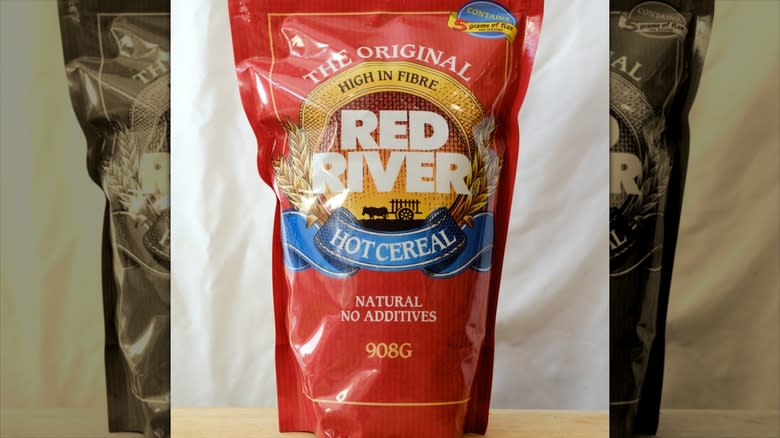
Manitoban Gertrude Skilling proved she had quite the skills in the breakfast department when she concocted a cereal that's still being enjoyed in Canadian households a hundred years on. Her Red River Cereal, named for the nearby valley, is a combination of grains, including cracked wheat, rye, flax, and whole flaxseeds. The boxed hot breakfast was originally marketed as "nutritious, vitalizing, laxative," and soon was used in recipes for all kinds of things, including sausage rolls, puddings, meatballs, shortbread, and pancakes. Writer Julie Lalonde summed up the cereal to The Guardian, saying, "I think of Red River as sort of like the Vegemite of Canada; either you like it or you don't, but it's iconic."
The JM Smucker Company acquired the cereal in the 1990s, but broke eaters' hearts when it discontinued Red River Cereal in 2021. This is where Canada's 6th oldest continuously operating business, Arva Flour Mill, stepped in and saved breakfast. Current owner Mark Rinker acquired the brand from Smuckers and has been selling it ever since in plastic bags. To celebrate and honor 100 years of Red River Cereal, Avra Flour Mills is releasing it in limited edition red and black boxes, in its original size of 1.35 kg. Rinker said in a press release, "We are honored to be the custodians of this historic brand and to continue its legacy for generations to come."
Table Talk Pies

Greek immigrants Theodore Tonna and Angelo Cotsidas met while working at a Worcester, Massachusetts bakery. When that bakery went up for sale, the two took it over. Speaking with the Worcester Telegram, Tonna's grandson Harry Kokkinis explained that, in 1924, the duo expanded "into pies because they felt pies represented America and everyone loves pie. They were trying to come up with a name for the company based on my grandfather's initials — TT — and agreed to call it Table Talk."
Pies soon became the bakery's main breadwinner, with the words "mother's only rival" proudly imprinted on its pans. By 1951, Table Talk kept the conversation going by introducing four-inch "Junior Pies" for 10¢, advertised as the "perfect idea for picnics, lunch boxes, snacks, desserts" (via The Boston Globe).
The company fell out of the families' hands when it was sold to Beechnut in 1965. Subsequent owners couldn't keep the bakery's bottom line fresh, and closed its doors in 1984. However, Theodore Tonna's son-in-law, Christos Cocaine had worked for the company and brought it back from the dead in 1986. With snack foods as popular as ever, he refocused the company on the four-inch pies with their classic white and red box. The pies cost over a dollar now, and still warm eaters' hearts. Kicking off its centennial, Table Talk Pies posted on Instagram, "We're grateful for every slice we've shared with you and look forward to many more moments that make life a little sweeter!"
Toms
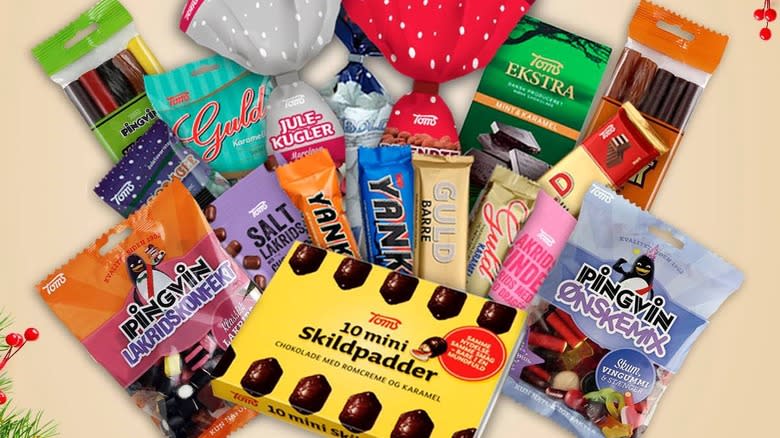
In 1924, Danish pharmacists Hans Trojel and Victor H. Meyer started filling prescriptions for candy lovers by creating and selling their own chocolates. Borrowing the first letter of each of their surnames, the brand was initially called ToM. Soon after, an "s" was added to the company name, so as not to confuse customers using their vending machines — in Danish, the word tom means "empty."
Two of the company's most famous candy bars are the Guld Barr (Gold Bar), introduced in 1932, and the toffee and nougat-filled chocolate Yankie Bar which came fourteen years later. The latter was designed with American soldiers and their sweet tooth in mind, as they were serving and gobbling them up in post-war Germany.
When Victor B. Strand assumed ownership in 1942, Toms not only modernized its business but also started to acquire other beloved candy makers. Under the Toms umbrella, labels such as Anthon Berg, Galle & Jessen, BonBon, Hachez, Feodora, and Høgh's licorice (which was redubbed Pingvin Lakrids, or "penguin's licorice"), have given Danes so many options to choose from that their stomachs will rarely be "empty."
Read the original article on Daily Meal.

